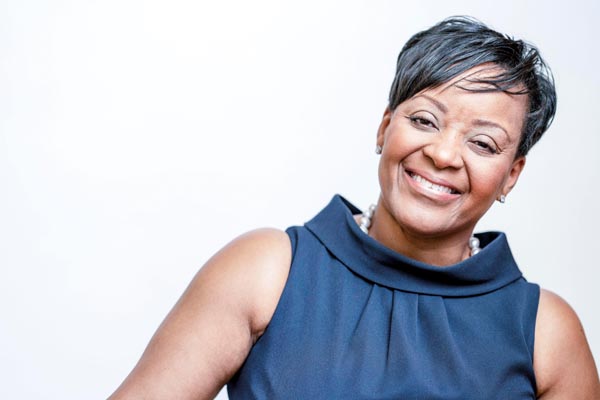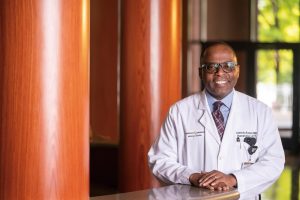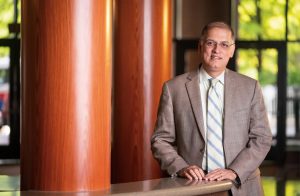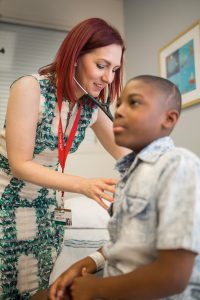Future Focused
August 2, 2019

Photo by John Russell
Sharon Seibert is among the more than 5,000 patients who have received a stem cell transplant at Vanderbilt-Ingram Cancer Center (VICC), which has one of the best survival rates in the nation and is at the forefront of new cellular therapies.
She considers herself blessed. As an African American, Seibert’s odds of matching with an unrelated donor were much lower than the likelihood for a Caucasian. She despaired when one of her sisters, who bears a close resemblance, wasn’t a match.
“I was absolutely devastated, because I know there’s not a lot in the pool for minorities,” she said. “I know there’s not, and so I just figured that’s just the kiss of death. I would roll the dice with the big stem cell registry.”
Fortunately, another sister stepped forward for testing and donated her stem cells.
“I didn’t think it was going to work because, in my head, she looks nothing like me. And she ended up being the one who saved my life,” she said.
Almost a decade after being diagnosed with chronic myelomonocytic leukemia, Seibert is healthy, has expanded her volunteer work and is enjoying life.
It’s a grueling process to undergo an allogeneic stem cell transplant from a donor.
First, cancer patients face the uncertainty of eligibility. If they do qualify for the potentially life-saving procedure, they then must initially endure the conditioning regimen with chemotherapy that depletes their bone marrow of normal and diseased cells to make room for healthy transplant cells — a process that results in myelosuppression and poses infection risks. There’s also the potential for other complications, including graft-versus-host disease (GVHD), which occurs when donor immune T cells begin attacking the recipient’s healthy tissue.
With decades of experience caring for a large volume of patients, the clinicians at the VICC Stem Cell Transplant Program have achieved a top survival rate for people receiving donated stem cells or allogeneic transplants. Between Vanderbilt University Adult Hospital, Monroe Carell Jr. Children’s Hospital at Vanderbilt and the adjacent Veterans Affairs medical center, the program now performs 350 to 400 transplants per year. This year, the program reached the milestone of having performed 5,000 transplants since its inception.
The VICC Stem Cell Transplant program has come a long way since the first allogeneic transplant from an unrelated donor occurred at Vanderbilt University Medical Center in September 1979. In the 1980s, the Robert J. Kleberg, Jr. and Helen C. Kleberg Foundation made two grants to support Steven Wolff, MD, in his pioneering research in autologous transplantation, which entails the removal, preservation and reintroduction of the patient’s own stem cells to regenerate the immune system after intensive chemotherapy and radiation therapy. The first grant went toward the acquisition of equipment to establish the program. With the second grant, the Wolff lab demonstrated the effectiveness of high doses of a chemotherapy drug called etoposide to wipe out cancer cells, followed by bone marrow transplant. This regimen is still in use today.
The stem cell program began as a small inpatient service that has become a highly respected program where most people undergo the procedure on an outpatient basis. Advances in human leukocyte antigen (HLA) typing, which is used to match stem cell recipients and donors, as well as patient monitoring and medications have greatly improved outcomes. In recent years, the VICC Stem Cell Transplant Program has treated patients without a good HLA match with haploidentical transplants, which are most often donated by a close family member, who is at least a 50% match, such as a parent or a child.
Patients also have access to the wide range of support services at the Medical Center, including a rehabilitation program designed just for them at Dayani Center.

Adetola Kassim, MBBS, MS, interim director of the Vanderbilt Stem Cell Transplant and Cellular Transplant Program, credits much of its success to the multidisciplinary support Vanderbilt provides. Photo by Joe Howell.
“That’s why people like me have stayed here and not considered leaving,” said Adetola Kassim, MBBS, MS, professor of Medicine and interim director of the Vanderbilt Stem Cell Transplant and Cellular Therapy Program. “It’s because of all this support, like the Dayani Center, having a good rehab center right across the street, psychiatric support, a nursing school — these are the attributes you need that allow you to foster and develop a unique program. We also have the benefit of one of the best Veterans Affairs (VA) hospitals close by with a world class transplant program that has had excellent stewardship over the years under Dr. Stacey Goodman. They now perform the largest number of stem cell transplants for eligible veterans in the country.”
On the pediatric side, Vanderbilt performs about 30 to 40 stem cell transplants per year, said Carrie Kitko, MD, Ingram Professor of Pediatric Oncology and medical director of the Pediatric Stem Cell Transplantation Program. Unlike the adult side, many of the children don’t have cancer, but rather have other diseases, such as sickle cell anemia or a compromised immune system that can be treated with a stem cell transplant.
Kassim has been with the stem cell transplant program for 18 years, part of an initial team brought in to grow the program with then-director Friedrich Schuening, MD, and Madan Jagasia, MBBS, MMHC, MS, chief medical officer of VICC and holder of the Beverly and George Rawlings Directorship.

Madan Jagasia, MBBS, MMHC, MS, has a breadth and depth of stem cell therapy expertise that spans his 18 years at VICC. Photo by Joe Howell.
“The stem cell transplant program at Vanderbilt-Ingram Cancer Center has grown over the last two decades from a regional program to one of national reputation for both its clinical outcomes and contributions to clinical research,” Jagasia said. “The investments made by our predecessors gave us the strong foundation to build upon. We continue to be poised for future success to further our service, education and research mission.”
Over the years, the team steadily improved outcomes and patient volume, in large part by developing an outpatient transplant program, starting in 2003. Three years later, the team established the Long-Term Transplant Clinic for systematic and multispecialty care of the transplant survivors, working closely with community-based providers.
Vanderbilt went from an adult inpatient program with about 20 beds to a nearly 60-bed unit. What once required a patient to stay hospitalized for one to three months can now be accomplished with outpatient procedures. The children’s program increased from four beds in the adult hospital to 19 beds in the freestanding Children’s Hospital that opened in 2004. This protected myelosuppression unit is shared with other oncology patients.
Thirty years ago, HLA typing to find matches wasn’t nearly as good as it is today, noted Becky Manes, MSN, RN, Pediatric Stem Cell Transplant program coordinator, who has been with Children’s Hospital for more than three decades, including the early days of the stem cell program.
“Supportive care is much better with more medications and treatments available compared to 30 years ago,” she said. “We didn’t have all the training that we do now. We didn’t have all the support of all the subspecialists with knowledge of managing transplant complications because we were just starting to perform the procedure.”
This support system includes child life specialists, financial counseling, the Family Resource Center, the hospital school program and pastoral care.
The VICC Stem Cell Transplant Program now ranks among the best in the nation for stem cell transplant survival rates among comparative programs, according to the annual report from the Center for International Blood and Marrow Transplant Research.
As Vanderbilt continued to expand the program, medical science and technology improved to make the program accessible to more patients. Stem cell transplants were once performed by extracting stem cells from the bone marrow of a donor, usually the patient’s family member, and giving them to a patient. But now stem cells can be extracted from donor blood and even with the use of umbilical cords (stem cells from a newborn).
VICC performs two primary kinds of stem cell transplants — known as allogeneic and autologous. With allogeneic transplants, the stem cells come from a donor or a donated umbilical cord. With an autologous transplant, the medical team extracts a patient’s own stem cells prior to high-dose chemotherapy, which would damage those cells. Then, the patient is infused with his or her own stem cells. Autologous transplant is used commonly to treat lymphoma and multiple myeloma, and in children, some solid tumors such as neuroblastoma and brain tumors.
It is also possible now for doctors to extract a patient’s immune cells, program them to fight the cancer and infuse them back into the patient, something called cellular or immune effector cell therapy. Vanderbilt is one of the few institutions in the country to currently offer it.
The founding of Be the Match, the National Marrow Donor Program, in 1986 greatly expanded the availability of transplants and led to the creation of an international registry of stem cell donors. “We can do transplants from a matched unrelated donor — that means if somebody matches you in England, we can do it, or Germany or Brazil or Canada,” Kassim said.

Carrie Kitko, MD, checks on Martavion Tinnel, a patient with sickle cell disease. Most pediatric stem cell transplant patients receive the therapy for a disease other than cancer. Photo by Daniel Dubois.
Kitko noted that pediatric transplant recipients almost always find a match and that outcomes with unrelated donors are now very similar to sibling donors, a near parity that only developed in the last decade. Thirty years ago, donors were much more difficult to find outside of sibling donors.
Yet, the health disparity, the difference between the odds of someone who is black and someone who is white finding a matched donor, remains a decade after Seibert received her transplant.
Caucasians have a 70% chance of finding a matching donor for a stem cell transplant because of greater representation in an international pool of stem cell donors, but only 17% of African Americans do, Kassim said. Even the chance of an African American having a full sibling matching donor is only 6% to 10%, he said. More donor diversity will lessen the health disparity.
Expanding treatment options are also improving the odds for minority matches.
“We’ve been able to cross a lot of racial boundaries,” Kassim said. “Our ability to overcome the HLA disparities with alternate donor options means that we can provide this lifesaving therapy to more people, including other ethnic minorities with equally dismal representation on the transplant registry and 30% of Caucasians who don’t have perfect matches in the registry.”
Seibert, the African American woman who received a transplant in 2011, described how discouraging it was trying to find other African Americans with her condition to be her guide. She was looking for testimonials to help her form a picture of what lay ahead.
“Searching stem cell transplant patient messages, books or videos, I didn’t see black people,” she said. “As far as looking to social media, we were not represented there either.”
Ultimately, she said she knew her Christian faith would show her the way.
Seibert’s recovery was rocky. After initially succeeding with the outpatient stem cell procedure, she had complications and had to return to the hospital for a lengthy inpatient stay. She developed graft-versus-host disease.
Her parents took pictures of her throughout the arduous process that she would turn into a book chronicling her journey. She initially wasn’t sure if the journey was toward recovery or death. She said her faith led her to be comfortable with either outcome.
“My face started turning black and I started looking monstrous by the first month,” she said, due to the chemotherapy. “Everything that was happening inside of me was now showing on the outside.”
But Seibert was determined. She returned to her role as a customer service manager for the Murfreesboro Water Resources Department in February 2012, just 10 months after her transplant, wearing a mask due to infection risks.
“I was afraid to come back to work,” she said.
But her daughter said, ‘Mom, you’ve always told us to try. And if it doesn’t work out then at least you tried,’ so I did.”
It was about three years after her transplant when she started feeling somewhat normal.
Today, “I feel great,” she said.
Now recovered, Seibert said she feels a greater sense of urgency to serve others. She stepped up her volunteer work with Rotary International and Toastmasters, and she looks for opportunities to encourage and coach others.
Better medications and improved supportive care have been integral to higher survival rates.
“I very firmly believe that you learn from each and every patient that you meet,” Kitko said. “In other words, 5,000 transplants to me means 5,000 stories that have collectively taught our group how to do transplants in a better and safer way. The transplants that are happening this year are so much safer than they were 15 to 20 years ago.”
Another advancement is more detailed HLA matchings.
“Probably one of the biggest steps forward is HLA typing,” Kitko said. “We have gotten much, much more sophisticated. Now, it is DNA-level typing. When we go back and look at studies from the late 1980s and early 1990s, what we thought were perfect matches then, now we realize are multiple mismatches.”
An additional factor for high survival rates is better medicines for infection prevention.
“Years ago, I remember that devastating call when we would take patients to the operating room and hear that black mold was in their sinuses,” Kitko said. “There was just nothing we were able to do for that. I think the other big advancement has been our understanding of graft-versus-host disease, being better able to monitor for it and treat it.”
Survival rates vary by disease, but overall, transplant recipients at Vanderbilt do better than the national average, Kassim said. He credits that to being meticulous about which patients will benefit from getting a transplant and also having a post-transplant care clinic. “A lot of the patients we transplant also are not from Nashville,” he said. “So being able to have a clinic dedicated to not only supporting them, but tracking their care, has been instrumental to improving their long-term survival.”
Seibert is now committed to spreading the word in the African American community, encouraging them to become stem cell donors. She is an advocate, contributor and promoter of the VICC Hematology Helping Hands Fund, which assists patients undergoing stem cell transplants and supports research projects.
At Vanderbilt, stem cell donors can help people throughout the United States and around the world through the Be The Match program.
“If you don’t plant the seed there will be no way for you to harvest,” Seibert said. “It’s not about you. It’s that giving spirit. You’re giving life without having to take one of your organs out. Be the giver. Be the gift giver for yourself or for somebody else.”
1 Comment
Sorry, the comment form is closed at this time.

As of yesterday, Aug 14, one year to the day in which I received my autologous stem cell transplant at VICC, I was told in Jan 2018 when diagnosed with a large cell, type B, non Hodgkins lymphoma, that I had been placed in the finest hands possible for treatment. Absolutely correct. the professionalism, skill, and compassion of the entire Ingram Cancer Center staff is beyond words to adequately describe.
Comment by William Baxter — August 15, 2019 @ 7:47 pm